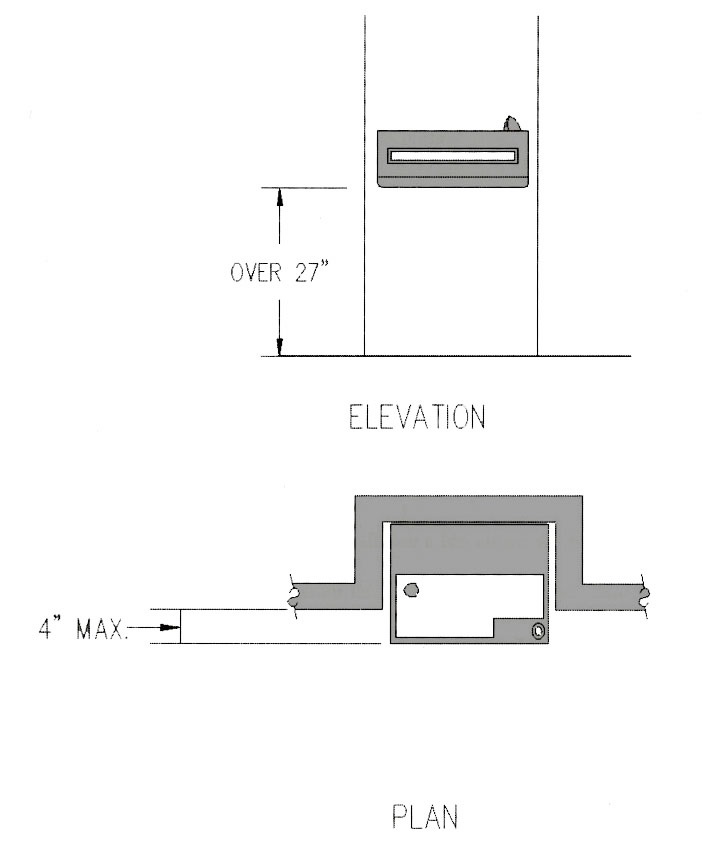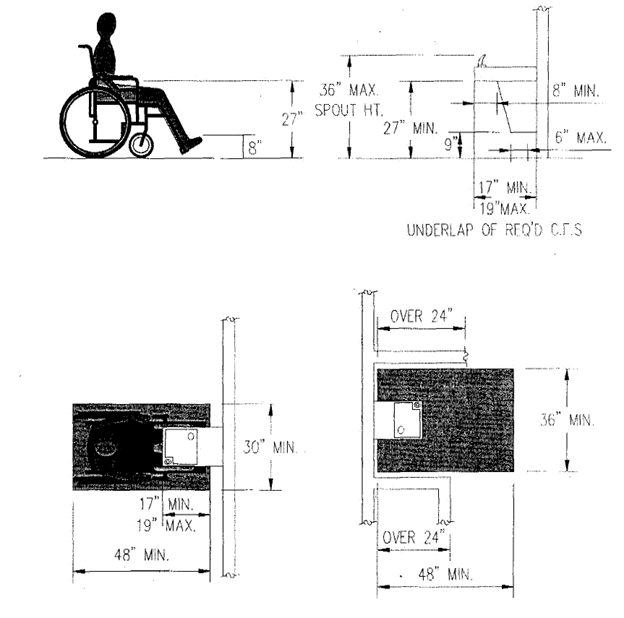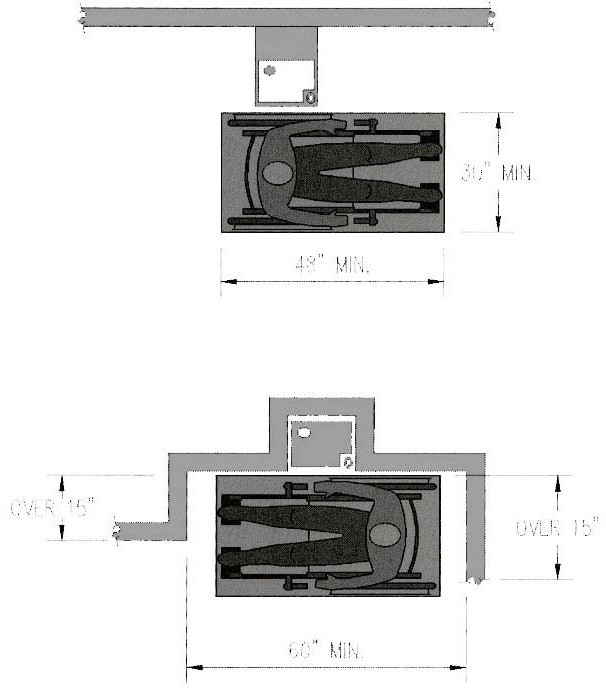Drinking Fountains and Water Coolers [4.15]
Drinking fountains and water coolers accessible to people who use wheelchairs may be too low for people with a limited ability to bend or stoop. ADAAG requires access for both user groups. Specifications in 4.15 address wheelchair access. Units that meet conventional industry standards are acceptable for providing access to people who have difficulty bending or stooping.
Plumbed Fixtures
ADAAG covers fixed units where they are provided. Fixed units are not required over units that are not fixed. Where non-fixed units are provided instead, consideration should be given to their usability by people who use wheelchairs and those who may have difficulty bending or stooping. Non-fixed units, such as bottled water coolers, are recognized as an option in providing additional access where only one fixed unit is provided on a floor.
Scoping [4.1.3(10)]
ADAAG does not specify the number of fixtures a building must have. Instead it requires access based on the number provided on each floor so that half (50%) are accessible to people who use wheelchairs. Recommendation: where an odd number of units is provided on a floor, one should round up to the next higher whole number in determining the number that provides wheelchair access.
One Unit Per Floor
Where only one fixed unit is intended on a floor, dual access can be provided by:
-
two separate units
-
a combination "hi-lo" unit
-
a fixed unit that is wheelchair accessible and a non-fixed unit (such as a bottled-water unit)
Recommendation: While other methods may be possible, fixed units are recommended over free-standing units because they require less maintenance and are more reliable from a compliance standpoint. Cup dispensers at fixed units are not recommended but if provided for dual access, the drinking fountain should be wheelchair accessible.
Exterior Sites
Recommendation: The 50% scoping required for building interiors should be followed for exterior sites. Where only one unit is provided or where they are spaced at considerable distances (such as over 200 feet), consider dual access at each location.
Dispersion
Recommendation: Wheelchair accessible units and standard units should be evenly dispersed to maximize convenient availability. For example, if a floor is occupied by separate tenancies, both types of units should be dispersed to serve occupants of each tenancy. Where only portions of a floor are accessible, such as wheelchair seating in assembly areas, be sure to locate wheelchair accessible units in proximity to, and on an accessible route from, accessible seating.
Standard Units
Units at conventional heights for use by standees are considered accessible to people who may bend or stoop with difficulty. It is important that cantilevered units meet the requirements for protruding objects so they do not pose a hazard to people with vision impairments. Recessing units in alcoves, wing walls, or other means of providing a detectable leading edge at or below 27 inches are acceptable.

Spout Location [4.15.3]
A person using a wheelchair has limited ability to lean over a drinking fountain, especially from a side approach. It is important that the spout be located at the front edge. The trajectory of water flow must be vertically "parallel" or "nearly parallel" to the face of the unit. Since rounded or oval bowls may not have a "front edge," a three inch distance is specified; the entire trajectory does not have to be within this distance.
Controls [4.15.4]
Controls must be operable with one hand and not require tight grasping, pinching, or twisting of the wrist to operate. Push bars are easier to use by a broader range of people because they can be operated with a closed hand, wrist, or forearm.
Forward Approach
Drinking fountains are easier to use from a forward approach than from a side approach. Clearances for a forward approach are required at cantilevered units. Knee and toe clearances can be provided at some fountains by locating the cooling mechanism or "chiller" in a wall recess. Clearances below units are specified to provide necessary knee and toe space while allowing room for plumbing. The clearance between knee and toe space is not specified but should be maximized to provide enough room for legs and shins. The 17 to 19 inch clearance depth allows people using wheelchairs to pull up far enough under the unit to reach the spout.

Additional maneuvering space is required at units recessed more than 2 feet. Recommendation: Consider allowing enough clear space for side approaches as well as for people who use scooters (most models have front tillers that will not clear the fixture for a forward approach).
Side Approach
Clear space for a side approach is specified for units that are free-standing or built-in. Space must be available so that a person using a wheelchair can align properly with the unit. Additional space is required where space is obstructed on both sides, which allows additional maneuvering for turns into the space. Recommendation: Since a close approach is often necessary, this space is helpful even at recesses less than 15 inches deep.


User Comments/Questions
Add Comment/Question